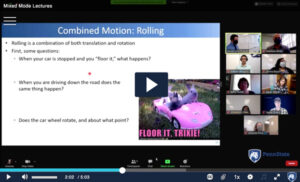Fall 2021
At this point, classes will be scheduled using the University’s standard (non-COVID) modes of instruction. Visit the Instructional Modes page to learn more about the fall 2021 plans and find related frequently asked questions.
On This Page
This instructional mode offers a mix of in-person and remote instruction achieved through classroom space rotation*, reducing in-person class time by including either remote synchronous or remote asynchronous instruction, using in-person class time for experiential learning elements, or some combination of these.
Each instructor will deploy their mixed-mode course in a way that works best considering the desired learning objectives. Some possibilities include:



In the rotation model, some students attend in-person sessions while others simultaneously attend those same sessions remotely. In the virtual enriched model, asynchronous or synchronous digital content is expanded upon in the classroom through engaging teaching strategies and/or in-person aspects that cannot be delivered remotely (e.g., labs, dance, art, etc.).
*If using spaced rotation, instructors will need to divide the class according to physical distancing guidelines for facilities — faculty support will be provided for this purpose.
Place: Room is assigned AND remote element provided (Zoom or other).
Time: Days and times are assigned.
LionPATH Code: CM – COVID Mixed Mode
Webinars and On-Demand Videos
Webinars and videos designed to provide critical information to faculty and staff about mixed-mode instruction.
On-Demand Videos
 Mixed-Mode Teaching Demonstration
Mixed-Mode Teaching Demonstration
Recommendations for engaging students when teaching in a mixed-mode environment are presented by the Harrisburg Center for Teaching Excellence, John A. Dutton e-Education Institute, and the College of IST’s Office of Teaching, Learning, and Assessment.
Next Live Webinar
Why It Works
- can reduce physical classroom time
- does not involve a complete redesign to the course, though up-front planning is required
- allows for activities that require in-person delivery (e.g., labs, dance)
- reduces on-campus class sizes to allow for physical distancing
- students rotated into in-class sessions still benefit from some in-person contact
- can optimize face time spent in engaged interaction
- high degree of flexibility for students
- in-person experiential elements are important for skills-based learning
- student engagement varies; creating a learning community is feasible
- switch to complete remote delivery would require little effort if pandemic worsens
- students who cannot or will not return to campus may still be able to participate, depending on the design of the class
Policies, Guidelines, and Documents
Frequently Asked Questions
Review the following frequently asked questions about mixed-mode instruction. For additional information, read all frequently asked questions.
Load More
Resources for Enhancing Your Teaching
The following instructional resources have been curated by educational developers and instructional designers and reviewed by faculty throughout the University. They are offered in the spirit of support for instructors who need to learn teaching in new modalities or who want to enhance their teaching effectiveness in familiar modalities.
On-Demand Resources
These resources are for faculty who prefer to learn on their own, with a “give me the information and I’ll apply what works for me” approach.
- Teaching Guide for Faculty for Mixed-Mode InstructionA comprehensive guide to course design and management in Canvas, including how to integrate Zoom and Kaltura when designing for mixed-mode instruction
- What Is Learning Design?A description of learning and design and collaboration from the College of Earth and Mineral Sciences
- Engaging your students with multimedia assignmentsA portal to a wide range of media-based assignments and support for students and faculty
- Strategies for Creating Engaging Synchronous and Asynchronous Learning EnvironmentsA list of strategies curated from across the University for engaging students in all remote delivery modes
- BlendLT Learning PathA deeper dive into the features and practices of blended or hybrid course design and practices
Collaborative Resources
These resources are for those who prefer to talk with colleagues or someone with expertise in learning or course design.
- Schedule a ConsultationIndividual consultations with course liaisons or find your college or campus instructional designer
- Faculty Instructional ConsultantsContact any consultant or find your College or Campus Liaison
- Tech Tutors and Tech TAs1-on-1 personalized technology support by talented Penn State students
- Engaging Students Series: Blending Asynchronous and Synchronous TeachingA series of synchronous sessions focused on student engagement for each delivery mode
- Talk with a University LibrarianA synchronous chat to engage with University librarians
“Explore Links and the Web” Resources
These resources are for instructors who prefer to do their own web research, exploring links and making conceptual and practical connections.
- Penn State Weblearning @ Penn State – Templates, Tools, and Resources A collection of resources for all web-based courses at Penn State
- Finding Open Educational Resources (OER)A guide to finding and using OER for your courses
- Open at Penn StateA broader guide to affordable, discoverable, and equitable access to information, scholarly research, educational resources, and research data within the University community
- Remote Resources for Penn State Library UsersOnline librarian consultations and resources for remote teaching
- Accessibility at Penn StateA site explaining how to ensure web pages and digital documents can be made accessible for users with different disabilities
- Best Practices for Teaching via Videoconferencing at Penn StateA guide for the best uses of synchronous videoconferencing for instructional purposes
“Do a Deeper Dive” Resources
These resources are for those who prefer a directed and structured learning experience, either self-guided and/or instructor-led.
- LinkedIn Learning
- Learning How to Increase Learner Engagement (42 min)
- Flipping the Classroom (42 min)
- IT Learning and DevelopmentTechnology training for Canvas, Zoom, Kaltura and more
